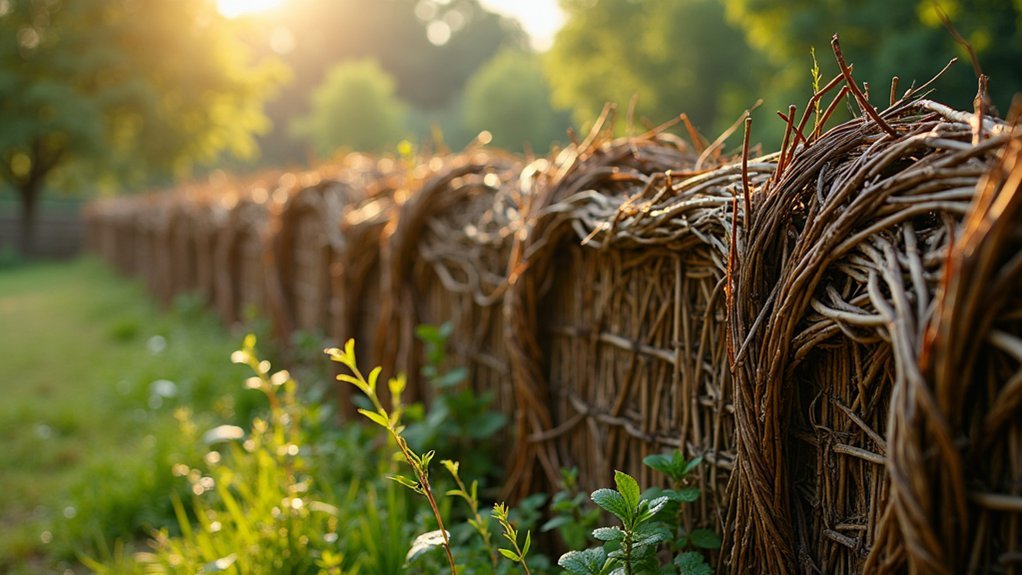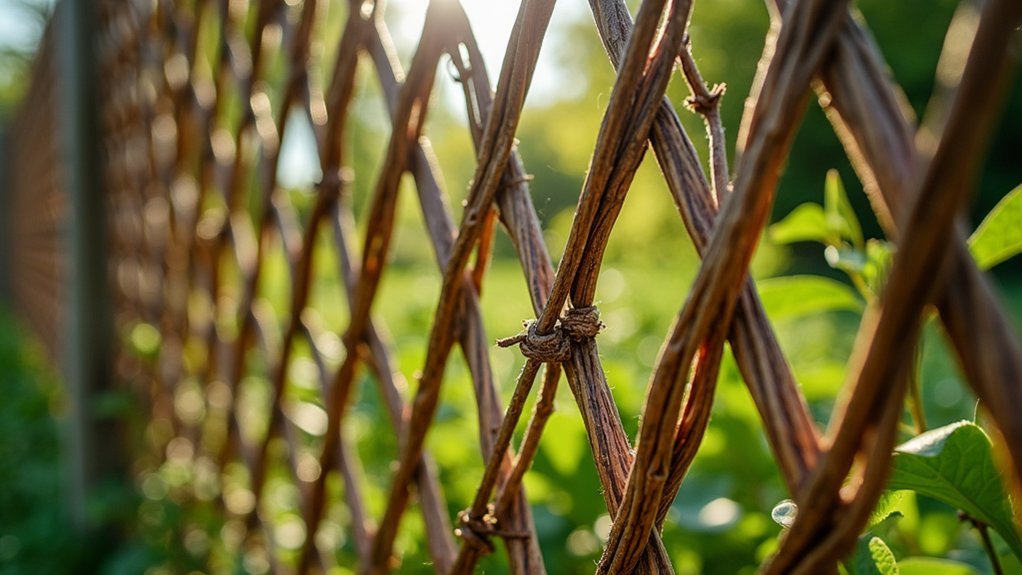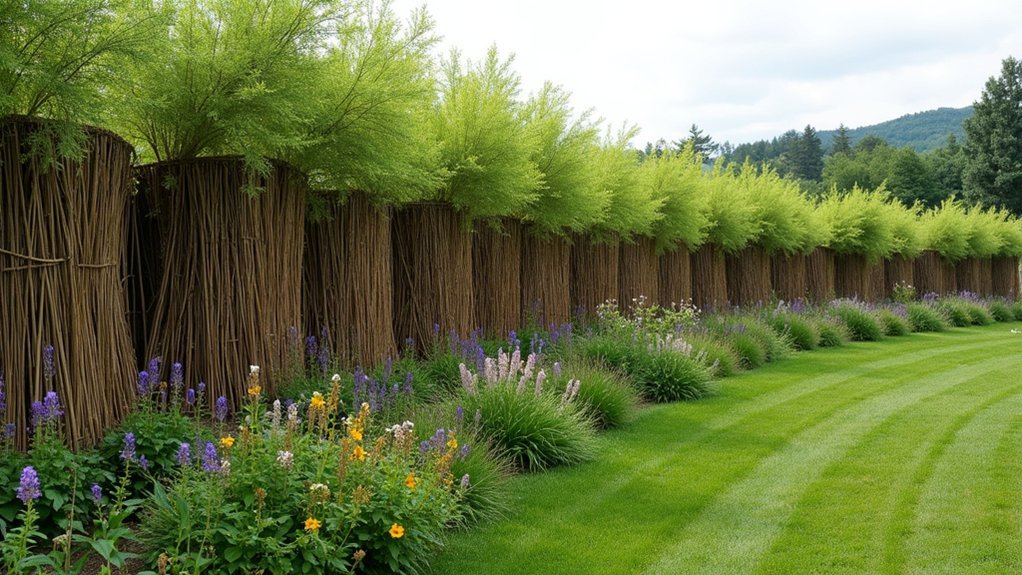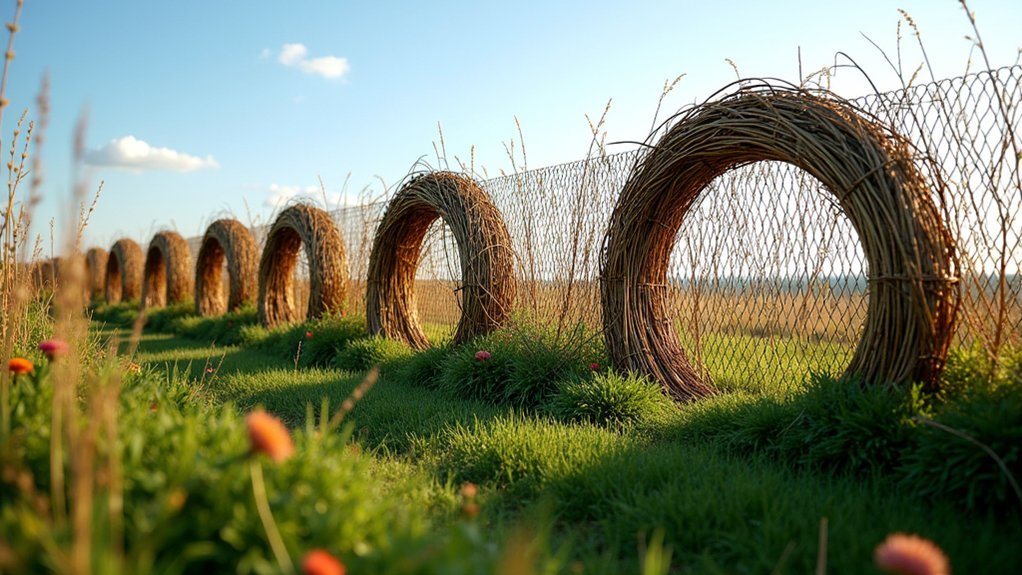For natural wind protection, consider these five willow windbreak designs: traditional woven hurdle panels that diffuse rather than block wind; living willow fedges that create dynamic ecosystems; diamond-pattern screens for ideal wind filtration; curved structures that redirect air while creating protected garden pockets; and layered willow-native plant combinations that enhance biodiversity. You’ll find these natural solutions offer both practical protection and visual appeal, blending seamlessly with your landscape. Discover how each design provides unique benefits for your specific outdoor challenges.
Traditional Woven Willow Hurdle Panels

Windswept gardens find their match in traditional woven willow hurdle panels, semi-permeable structures that brilliantly diffuse wind energy rather than blocking it completely.
Traditional willow hurdles transform windswept gardens with their semi-permeable genius, diffusing gusts rather than fighting nature’s force.
This natural barrier reduces pressure on your fencing system, enhancing durability in particularly blustery locations.
You’ll appreciate the rustic charm these panels bring to outdoor spaces while serving a practical purpose. Crafted from flexible yet sturdy willow branches, they create a living fence appearance that blends seamlessly with garden landscapes.
Choose between standard woven designs that maximize wind passage or bunched weave styles for extra sturdiness.
With proper maintenance, including occasional pruning, your willow hurdles can last up to a decade.
Their organic aesthetic makes them perfect for cottage gardens and wildlife areas where you want protection without sacrificing natural beauty.
Living Willow Fedge (Fence-Hedge Hybrid) Systems
While traditional fences merely block wind, living willow fedges transform your garden boundaries into dynamic ecosystems.
By planting Salix viminalis cuttings closely together, you’ll create a beautiful and natural structure that grows 6-10 feet tall in just a few years.
Your living willow fence offers superior wind protection as branches intertwine to form a dense barrier.
This natural windbreak doesn’t just create shelter for your garden—it provides valuable habitat for beneficial insects and birds, enhancing your property’s biodiversity.
For the best results, implement regular maintenance through pollarding and strategic trimming.
This keeps your fedge healthy and maintains its desired shape and density.
You’ll enjoy both the practical benefits of wind protection and the visual appeal of lush greenery that changes with the seasons.
Diamond-Pattern Willow Screens for Maximum Wind Filtration

The diamond-pattern willow screen offers an ingenious solution to wind management in your garden or landscape. Unlike solid barriers that create turbulence, these screens allow air to pass through while effectively reducing strong gusts, creating a more comfortable outdoor space.
You’ll appreciate how the interwoven diamond structure distributes wind pressure evenly across the fence, enhancing its stability during storms. This distinctive geometric pattern also adds visual interest to your property.
For ideal performance, customize your screen’s height and spacing to match your specific terrain and wind protection needs.
Don’t neglect maintenance—regular pruning and reshaping will preserve both functionality and appearance over time.
The diamond-pattern design balances practical wind filtration with aesthetic appeal, making it an excellent choice for environmentally conscious landscaping.
Curved Willow Windbreak Structures for Garden Microclimates
Designing curved willow windbreaks transforms ordinary gardens into sheltered havens where plants thrive and outdoor enjoyment flourishes. Unlike straight fence lines, these graceful living structures effectively redirect wind while creating secluded pockets perfect for sensitive plantings.
Plant your willow cuttings just one foot apart in gentle curves to establish a dense, natural barrier. You’ll watch as they quickly develop into a lush green screen that blends beautifully with your landscape while providing robust protection against harsh weather.
For maximum benefit, incorporate diverse plant species alongside your curved windbreak to attract beneficial wildlife.
Don’t forget regular pruning to maintain both density and your desired shape. This maintenance guarantees your willow fence remains effective while enhancing garden aesthetics and generating microclimates that extend your growing season considerably.
Layered Willow and Native Plant Combination Barriers

Creating resilient landscapes becomes effortless when you combine willow structures with native plant species in layered windbreak designs. These integrated barriers support biodiversity while providing superior wind protection. Your layered willow barriers work harmoniously with native plants to enhance ecosystem health and reduce maintenance needs.
| Plant Type | Benefits | Placement |
|---|---|---|
| Tall willows | Primary wind barrier, wildlife habitat | Outer row |
| Mid-height shrubs | Fills gaps, provides berries | Middle row |
| Flowering natives | Attracts pollinators, aesthetic appeal | Inner row |
| Ground covers | Prevents erosion, crowds out weeds | Base layer |
Design your windbreak with varying heights to maximize effectiveness. You’ll create not just a functional barrier against wind, but also a dynamic ecosystem that changes with the seasons, requiring less water and care than conventional windbreaks.
Frequently Asked Questions
Which Willow Is Best for a Fence?
For a fence, you’ll find Salix Viminalis (Common Willow) most effective as it grows 6-10 feet in just one year. If you’re seeking aesthetics too, consider Chinese Willow with its large catkins.
What Is the Best Fence Design for Wind?
For wind resistance, you’ll want a semi-permeable fence that allows some airflow. Choose staggered, layered designs with vertical supports. Don’t build solid barriers that create pressure points where winds can topple your fence.
How Long Will Willow Fencing Last?
Your willow fencing will last 5-10 years when you properly maintain it. You’ll maximize its lifespan with regular pruning, using thicker stems, and implementing grafting techniques. Don’t forget to check for pests regularly.
What Is an Alternative to Willow Fencing?
You’ll find several alternatives to willow fencing: hazel hurdles provide natural wind resistance, living fences create wildlife habitat, fabric screens offer flexibility, traditional wooden fences provide durability, and portable barriers work well for temporary solutions.
In Summary
You’ve now explored the top five willow windbreak options for your property. Whether you’ve chosen the traditional hurdles, a living fedge, diamond-pattern screens, curved structures, or layered plant combinations, you’re well-equipped to create an effective, natural barrier. Don’t wait to start your project—these sustainable willow designs will protect your space while adding natural beauty to your landscape for years to come.





Leave a Reply